Next-Gen Diabetes Care: Why, What, and How? Hear From Eight Great Leaders!
By Emma Ryan
 Kelly Close and Adam Brown led two panels on next-generation diabetes at The diaTribe Foundation’s third annual gathering during ADA 2018; plus highlights from the “after hours” fireside chat on patient-centric innovation
Kelly Close and Adam Brown led two panels on next-generation diabetes at The diaTribe Foundation’s third annual gathering during ADA 2018; plus highlights from the “after hours” fireside chat on patient-centric innovation
At the 78th American Diabetes Association (ADA) Scientific Sessions in Orlando, The diaTribe Foundation hosted our third annual “Musings Under the Moon” gathering focused on next-generation diabetes technology and therapy. Kelly Close, Founder of The diaTribe Foundation, and Adam Brown, Senior Editor at diaTribe and author of Bright Spots & Landmines, co-moderated two panels of industry leaders:
-
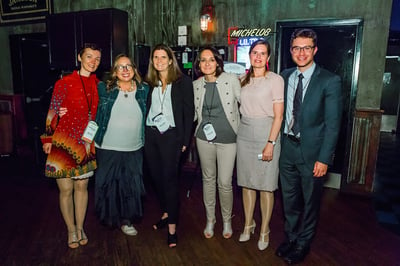 Michelle Carnahan – North America Head, Diabetes and Cardiovascular, Sanofi
Michelle Carnahan – North America Head, Diabetes and Cardiovascular, Sanofi -
Sophie Dutilloy – Divisional VP and Commercial Lead, EU, Africa & Middle East, Abbott
-
Marie Schiller – Vice President, Connected Care and Site Head, Cambridge Innovation Center, Lilly
-
.jpg) Camilla Sylvest – Executive Vice President, Commercial Strategy & Corporate Affairs, Novo Nordisk
Camilla Sylvest – Executive Vice President, Commercial Strategy & Corporate Affairs, Novo Nordisk -
Jennifer Block – Vice President of Clinical and Medical Affairs, Bigfoot Biomedical
-
Annika Jimenez – Senior Vice President, Data, Dexcom
-
Shacey Petrovic – President and COO, Insulet
-
Laura Stoltenberg – Vice President of MDI Solutions, Medtronic Diabetes
Later that evening, we were joined by Manny Hernandez, SVP of Learning and Culture at Livongo for an intimate fireside chat.
The expert panelists shared insights ranging from the role of people with diabetes in driving innovation, to industry collaboration, access, and ways to help people think less about diabetes. See some of our favorite quotable quotes below!
A-HA Moments, Tradeoffs, and Progress
-
.jpg) Q: What would you put on a billboard that anyone with diabetes or healthcare provider could see? “I came into diabetes, and I was in a market research session sitting across from a woman with type 2 diabetes. She said, “Only my husband knows I have this because there would be so much judgement. People would say ‘it’s my fault because I’m fat and lazy.’ If you could put ‘diabetes proud’ [on a billboard] it would do a ton of good. Anyone who could only tell their husband – how could they get what they need?” – Michelle Carnahan (Sanofi)
Q: What would you put on a billboard that anyone with diabetes or healthcare provider could see? “I came into diabetes, and I was in a market research session sitting across from a woman with type 2 diabetes. She said, “Only my husband knows I have this because there would be so much judgement. People would say ‘it’s my fault because I’m fat and lazy.’ If you could put ‘diabetes proud’ [on a billboard] it would do a ton of good. Anyone who could only tell their husband – how could they get what they need?” – Michelle Carnahan (Sanofi) -
“Diabetes proud. This is a disease where there’s too much blame. We have to be diabetes proud and have optimism that things will be better.” – Laura Stoltenberg (Medtronic)

“The people I lost sleep over weren’t going to use automated insulin delivery. 66% of adults with type 1 diabetes in the US are seeing primary care providers (PCPs) as their only method of care; this is a group that I had to learn was, unlike me, scared of insulin.” – Jennifer Block (Bigfoot Biomedical)
-
“An A-HA moment from this past year was the new connected pen that was launched in Sweden and looking at how it improved dialogue between patients and providers. The pen can connect and send insulin dose information to the doctor, and it is amazing to see what an impact that makes.” – Camilla Sylvest (Novo Nordisk)
-
“We’re always wrestling with ease of use, functionality, simplicity. We’re part of an elite class that has awareness of pumps, CGM, smart pens – all of that. How do you make a device that’s usable for the masses and that’s simple and intuitive, but also has the features everyone wants and is competitive in the market?” – Shacey Petrovic (Insulet)
-
 “The way we think about it is value vs. burden. If we want to bring additional value, whether that’s a unique insight on time-in-range, sleep, or less hypoglycemia, but we’re asking someone to do something that they’re not doing today, then we have to be really careful about the burden.” – Laura Stoltenberg (Medtronic)
“The way we think about it is value vs. burden. If we want to bring additional value, whether that’s a unique insight on time-in-range, sleep, or less hypoglycemia, but we’re asking someone to do something that they’re not doing today, then we have to be really careful about the burden.” – Laura Stoltenberg (Medtronic) -
“I’ve had to re-learn and re-prioritize what I want the products to do. I’m now so interested in moving A1Cs at the upper range (e.g., above 9%) down, and far less concerned about fine tuning” – Jennifer Block (Bigfoot Biomedical)
-
“People often don’t have access to healthcare. Someone thought a muffin was a healthy breakfast, but that changes when you see what a muffin does to your blood sugar. Technology can do amazing things, and it can be simple like a virtual clinic – it’s not just pumps and connected pens. We need an ecosystem of support around those things.” – Michelle Carnahan (Sanofi)
-
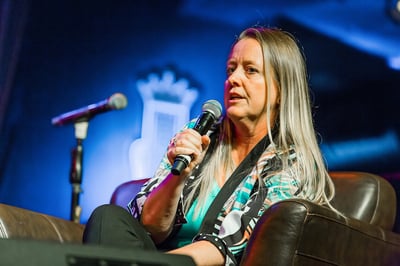 "We’re at the beginning of applying machine learning to data, and that has a lot of challenges. Inherent expectation of transparency, and that’s another tradeoff conversation. How transparent can we get? But I think patients and HCPs are not okay with black boxes. So, if our algorithm predicts X, how transparent should we be? What features can it be narrowed down to? Really lay it out there so people understand it." – Annika Jimenez (Dexcom)
"We’re at the beginning of applying machine learning to data, and that has a lot of challenges. Inherent expectation of transparency, and that’s another tradeoff conversation. How transparent can we get? But I think patients and HCPs are not okay with black boxes. So, if our algorithm predicts X, how transparent should we be? What features can it be narrowed down to? Really lay it out there so people understand it." – Annika Jimenez (Dexcom)
On “Less is More”
-
“There’s a lot of tech and molecules and telehealth, but I don’t know if we really understand what it means to make someone with diabetes happy.” – Shacey Petrovic (Insulet)
-
“People don’t just want their A1C to be lower, they want “normalcy” in their lives. To live simpler, with a higher degree of wellness. There’s so much more to be done.” – Michelle Carnahan (Sanofi)
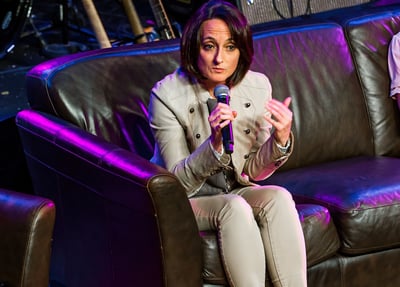
“We want people to engage with our products and the way to do that is let them live their lives like they intend to. How can we make products simple?” – Sophie Dutilloy (Abbott)
-
“When we talk to experts about diabetes and people living with diabetes, they say, ‘we would really like you to help us forget about our disease and live our lives.’ We can invent a lot of apps and tech that keep reminding people about their disease – check the app, check your sugar – but all that patients are trying to do is get away from it and live a normal life. Our goal is to support people with diabetes with enough care, but not more than what it takes to live normal life: making a complicated solution very simple.” – Camilla Sylvest (Novo Nordisk)
-
“Simple is so much harder than any of us really understand. It comes with a lot of tradeoffs; to make those tradeoffs, one of the things we’ve really learned is that you have to understand the entire ecosystem. The needs of healthcare providers are really different than the needs of people with diabetes.” – Jennifer Block (Bigfoot Biomedical)
-
“We all need to have patient privacy at the center of what we are doing, and apply robust processing in a way that delights and lessens the burden of diabetes.” – Annika Jimenez (Dexcom)
-
“You don’t have to be on tech or devices all the time to get insights…The appropriate use of tech is to drive insights that give the “aha” moment - even if it’s just one takeaway.” – Laura Stoltenberg (Medtronic)
On Collaboration
-
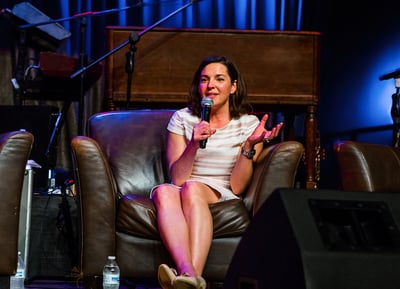 “Patients share a voice. We’re just starting to talk about the way the OpenAPS and Night Scout communities came together. In this market, I see the patient voice driving things, and it’s only getting stronger. It’s remarkable.” Shacey Petrovic (Insulet)
“Patients share a voice. We’re just starting to talk about the way the OpenAPS and Night Scout communities came together. In this market, I see the patient voice driving things, and it’s only getting stronger. It’s remarkable.” Shacey Petrovic (Insulet) -
“I looked at regulation as the burden I had to go through to get what I wanted and that has completely changed as I’ve seen how the FDA has been pushing industry to respond to the strong desire from the patient community to move faster. That has changed in parallel to my very new, strong appreciation for the DIY community that has really driven the whole notion of open source in an industry that really does not like open source. This is not a trivial prospect, so I understand what Loop and openAPS have really accomplished in catalyzing this pace of innovation. For us to leverage in that pace of innovation will require an epiphany for a lot of us. We can embrace that community rather than let it be on its own.” – Annika Jimenez (Dexcom)
-
“We need more ‘YES, AND..”, because I’m so tired of the ‘YES, BUT…’” – Marie Schiller (Lilly Cambridge Innovation Center)
-
“I’m super excited about Dexcom’s G6 iCGM, but what that means is we have to accelerate how we integrate with all of our partners. That’s the expectation that the FDA is setting for us. Suddenly, we don’t just have to be really great at the core components of CGM, we have to be great integrating the core components of our partners.” – Annika Jimenez (Dexcom)
-
“There’s partnership and then there’s ownership. How we work together is complicated, and there’s a long way to go.” – Kelly Close (The diaTribe Foundation)
On Access
-
“The speed of adoption for the Libre has really been driven by the pressure of patients through petitions to governments and the sheer pressure they apply to get access to this device. It has been fascinating to see the impact.” – Sophie Dutilloy (Abbott)
-
“We have amazing therapies, we have incredible tools, and we have got to find a way to finish the final mile. We have to really understand what’s hard and help people have access.” – Jennifer Block (Bigfoot Biomedical)
-
 “Only 6% of people with diabetes are actually in good control; that’s the real battle we have to fight. We are working a lot on how we can change that. We’ve worked on this for almost 100 years. All of the innovations we’ve created – how do we complement those with the tech we discussed? How can we do that in a way where we can make leaps forward and not just be happy with 6% in good control? We’re not happy with that, and no one should be. That’s a fight we really need to win.” – Camilla Sylvest (Novo Nordisk)
“Only 6% of people with diabetes are actually in good control; that’s the real battle we have to fight. We are working a lot on how we can change that. We’ve worked on this for almost 100 years. All of the innovations we’ve created – how do we complement those with the tech we discussed? How can we do that in a way where we can make leaps forward and not just be happy with 6% in good control? We’re not happy with that, and no one should be. That’s a fight we really need to win.” – Camilla Sylvest (Novo Nordisk) -
“What if we’re forced to make an innovation vs. access decision? I don’t want to live with [that choice], I don’t want my children to live with it…We’ve got to address it because we’re going to be faced with this question.” – Michelle Carnahan (Sanofi)
-
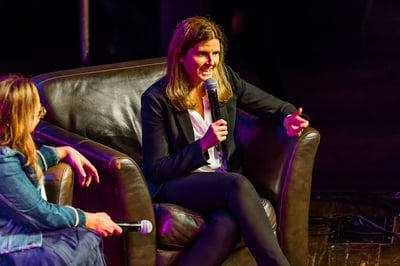 “Here’s a real one: if we can make connected pens and use blood glucose meters that are cheaper than CGMs, should we try do this? Or should we only use pens with CGM data? I think we need to innovate around access and change how we get paid.” – Marie Schiller (Lilly Cambridge Innovation Center)
“Here’s a real one: if we can make connected pens and use blood glucose meters that are cheaper than CGMs, should we try do this? Or should we only use pens with CGM data? I think we need to innovate around access and change how we get paid.” – Marie Schiller (Lilly Cambridge Innovation Center) -
“When I talk to the average healthcare provider or patient, they associate technology with complexity. What we’re trying to do is to use tech to provide simplicity, and we tried to do that with Omnipod Dash by incorporating consumer tech skillsets into our technology.” – Shacey Petrovic (Insulet)
-
“I’m terrified of number of healthcare providers exiting diabetes care, and how challenged we’re going to be to find skilled experts to support people with diabetes. We’re going to do a lot to innovate, and you’ve heard from a lot of people doing incredible work. I have type 1 diabetes, and I don’t know who’s going to take care of me when I’m older. I’m really worried about it.” – Jennifer Block (Bigfoot Biomedical)
Musings After Hours
Later in the evening, Livongo’s Manny Hernandez and Adam Brown discussed diabetes innovation strategy and patient-centricity in a stimulating hour-long "After Hours" fireside chat. Here are some of our favorite moments:
-
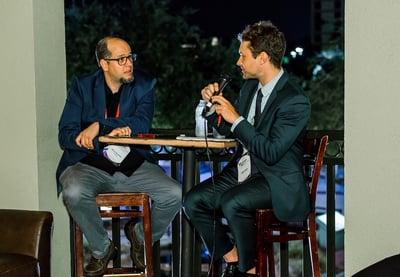 “On the digital coaching side, there’s an amazing opportunity to take advantage of machine learning. We have a library of possible recommendations based on certain scenarios and recent patterns. These insights get surfaced through technology in a way to educate without relying on an actual coach.” – Manny Hernandez
“On the digital coaching side, there’s an amazing opportunity to take advantage of machine learning. We have a library of possible recommendations based on certain scenarios and recent patterns. These insights get surfaced through technology in a way to educate without relying on an actual coach.” – Manny Hernandez -
“How do we encourage more people to feel safe and comfortable with behavioral interventions? There’s potential to be empowered, but the stigma and fear of opening up is real. All of us have an opportunity, as we consider solutions in development, to think about how we can empower the users of those solutions to feel more confident.” – Manny Hernandez
-
“We need to remove friction points – daily logging, getting strips – so people with diabetes can focus on what is most important to their care.” – Manny Hernandez







